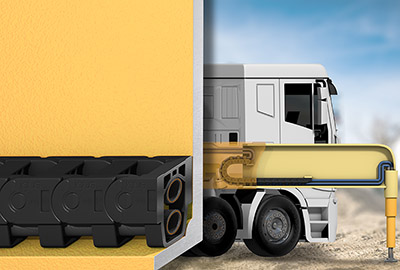 igus has introduced a new E2 hydraulic chain that serves as an energy and media guide even for small installation spaces on support legs.
igus has introduced a new E2 hydraulic chain that serves as an energy and media guide even for small installation spaces on support legs.
Strong, space-saving and easy-to-install, the igus e-chain guides two hydraulic hoses in addition to power and control cables. The E2 hydraulic chain is an ideal solution for special mechanical engineering, and its use significantly reduces the costs of maintenance and downtime. igus, the German-based manufacturer of motion plastics, runs its North American operations out of Providence, R.I.
Support legs on many construction machines, such as concrete pumps or mobile cranes, are characterized by a large variety of models and components. The safe guidance of hydraulic hoses is crucial, because they need to be reliable under high mechanical stress and strong weather conditions.
The E2 hydraulic chain from igus provides efficient protection to internal cables and prevents torsion and bending of the hoses through the predefined minimum bend radius.
For a long time, igus has been using “extender crossbars” to create additional interior space for the guidance of hoses. For the E2/000 series and the E4.1 and E4.1L systems, extender crossbars, in addition to normal crossbars, can be used with high holding power to accommodate additional hoses with larger diameters.
The new chain provides energy and media guidance with one system. For the new E2 hydraulic chain, the concept was applied to the installation space-specific conditions of support legs on concrete pumps and mobile cranes. A one-piece, solid extender crossbar design and the heavy-duty pin/bore connection ensure high strength, even for large unsupported lengths. The extender crossbars are injection moulded directly on the side link and thus offer optimal hose guidance and stability.
It is also possible to place two hoses safely — one above the other. Because energy and hydraulics can be guided within a single hydraulic chain, the requirement for installation space is reduced. The hydraulic chain has an external width of just 41.2 mm and an external height of 57.5 mm. The predefined minimum bend radius is 75 mm. The total required installation height for the chain is only 255 mm. Thus, the E2 hydraulic chain can be integrated into almost any application, such as close to the base or on the side wall of support legs, a concrete pump or a mobile crane.
Because hydraulic hoses, which are usually operated at extremely high pressure, need to endure a lot in dynamic applications, they are very maintenance-intensive.The E2 hydraulic chain meets this challenge in two ways: The extender crossbars and e-chain are made of tribologically optimized plastic. This reduces the abrasion and protects the hoses.
Its design also reduces wear to a minimum. Both the extender crossbars and the interior of the chain are designed to protect the hose. Rounded contours and wide and smooth contact surfaces keep abrasion and wear of the hydraulic hoses low.
The segmentation of the cable types also reduces the strain on the cables. Electrical and hydraulic guidance is completely separated by chambers. This follows the principle that cables and hoses with very different diameters should always be run separately. This is important because power or control cables have a maximum thickness of 5 mm, while the hydraulic hoses can be up to 20 mm.
Normally a clearance space of 20% is required, as hydraulic hoses expand transversely and lengthwise when pressurized. Designed to the last detail, the E2 hydraulic chain can offer freedom from maintenance.
igus
www.igus.com
Filed Under: Hose Assembly Tips